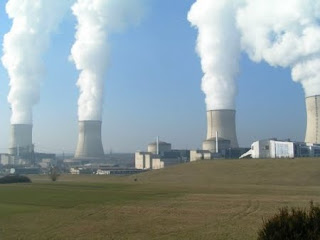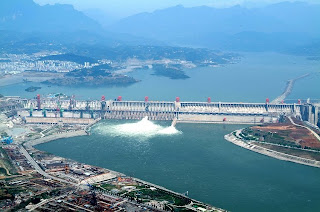Wednesday, June 30, 2010
Hiatus
Thank you to all of our readers.
Taking a break from blogging to focus on other things...
Will return to posting after a while.
Update: I am no longer with Hydrovolts. Check out my new blog.
Taking a break from blogging to focus on other things...
Will return to posting after a while.
Update: I am no longer with Hydrovolts. Check out my new blog.
Monday, June 28, 2010
Crude Behaviors
The Obama Administration's attempt to halt deepwater oil drilling temporarily with a six-month moratorium is, unsurprisingly, under attack. Federal district court judge Martin Feldman of the Eastern District of Louisiana overturned it last week, but his motives are clearly suspect:
Judge Feldman not only held numerous oil and gas interest stocks, but was trading them up to and including the morning of his fateful decision, and doing so out of an admitted realization that he had an appearance of ethical conflict. Feldman owned and was trading Exxon stock, a company whose Gulf of Mexico rigs were losing money at the rate of a half million dollars a day due to the moratorium, during the entire time he was assigned the case. Yet, failing to disclose his appearance of conflict on the record or recuse, Feldman nevertheless proceeded to issue a questionable decision clearly benefitting the oil and exploration industry he is so invested in.So why, when the Government appealed this decision, did they not raise the glaring conflicts of interest?
[snip]
Even more distressing is the fact that it has now been revealed from Judge Feldman’s 2009 financial disclosure, literally just filed and only released this week after demand resulting from his questionable ruling, that Feldman is very heavily invested in Blackrock Financial products. Blackrock is, of course, the single biggest shareholder in BP.
Labels:
energy policy,
fossil fuel,
Lousiana,
politics,
regulation
Tuesday, June 22, 2010
Eight Is Enough
Jon Stewart in one of his typically acerbic pieces on the promise of oil independence:
Coming on the heels of President Obama's speech on the BP spill, and with video clips detailing 4 decades of imprecations and high-minded exhortations from 8 presidents, Stewart complains, roughly, "Fool me once, shame on you. Fool me twice, shame on me. Fool me 8 times, I am a freaking idiot."
We fail to demand real action from our leaders, or to hold them accountable for mouthing bromides. With our current president, I fear the audacity hope has become the folly of wishful thinking. As Pogo said, originally in a poster for Earth Day 1970, "We have met the enemy, and he is us."
Video here.
(h/t earth2tech)
Coming on the heels of President Obama's speech on the BP spill, and with video clips detailing 4 decades of imprecations and high-minded exhortations from 8 presidents, Stewart complains, roughly, "Fool me once, shame on you. Fool me twice, shame on me. Fool me 8 times, I am a freaking idiot."
We fail to demand real action from our leaders, or to hold them accountable for mouthing bromides. With our current president, I fear the audacity hope has become the folly of wishful thinking. As Pogo said, originally in a poster for Earth Day 1970, "We have met the enemy, and he is us."
Video here.
(h/t earth2tech)
Saturday, June 19, 2010
Faint Hope
President Obama's lack of conviction on climate and energy policy is now undeniable. His vacillating remarks on off shore oil drilling over the past few months illustrate his lack of leadership on this, the most critical issue of his presidency.
Eric Pooley over at Grist has an excerpt from his forthcoming book which lucidly surveys the Obama Administration's timeline of timidity. He concludes:
Pooley hopes that public anger will prod a sclerotic Congress into passing a climate bill. However, public anger is attenuating from the steady trickle of bad news and is increasingly eager to look for other targets, particularly within the federal government. The oil lobby and their drill shills in the chattering classes are working hard, incredibly, to recast the oil disaster as an example of why government involvement is bad. (The argument, in defiance of both reason and evidence is roughly: Regulatory oversight failed, thus regulation is worthless, and so government should do nothing, except perhaps foot the bill.) The mob is searching for scapegoats of which to make an example, and the focus is punitive rather than constructive. It is absurd to hope that the public, exhausted from bad news, beset by economic gloom, incited by partisan hacks, and frustrated by collective impotence will spur a Congress captive of corporate interests to do other than pander to the electorate while they stroke entrenched incumbents.
Hope is not a plan. Obama's unwillingness to articulate a bold plan (or even a bold hope) contributes to the perception that our government is adrift. Worse, it reinforces the belief that government is incapable of solving problems, in turn making bold action even harder. On energy policy, this will guarantee the decline of American competitiveness. It is well past time for Obama to be a leader, not a mediator.
Eric Pooley over at Grist has an excerpt from his forthcoming book which lucidly surveys the Obama Administration's timeline of timidity. He concludes:
It is a cruel irony that the epic disaster in the Gulf -- a wakeup call to the need to reduce our dependence on oil -- makes it harder to pass a bill that would help us do so. Expanded offshore drilling (and the revenue it would bring) was the chip Obama hoped to use to draw oil-state senators into a grand bargain that would also include subsidies for nuclear power and carbon capture and storage, with a modest carbon cap in return. The oil spill blew up that idea by taking expanded offshore drilling off the table, at least for now. With few chips left, Obama appears to be hoping that public anger over the spill can help drive a new version of the climate bill. Soon, we’ll know whether he really means it. Democratic leaders in the Senate have been floating the idea of an energy bill without a carbon cap -- which would be yet another failure of nerve by a group of legislators badly in need of adult supervision. Passing a real climate bill will be excruciatingly difficult. Waiting will only make it harder. It’s time for Obama to intervene on the Hill, silence the naysayers inside his own administration, harness the public mood, and make good on his promise to fight.So this is what the audacity of hope looks like--wishing for the First Nerd to remove his figurative glasses and punch back at the bullies. But he won't. Ever cerebral, Obama doggedly appeals to the non-existent good intentions of his opponents, believing that reason and patience will yield agreement. In time, onlookers feel contempt, not sympathy. The notion that Obama will risk any political capital to lead a fight is not a bold hope, but a limp wish.
Pooley hopes that public anger will prod a sclerotic Congress into passing a climate bill. However, public anger is attenuating from the steady trickle of bad news and is increasingly eager to look for other targets, particularly within the federal government. The oil lobby and their drill shills in the chattering classes are working hard, incredibly, to recast the oil disaster as an example of why government involvement is bad. (The argument, in defiance of both reason and evidence is roughly: Regulatory oversight failed, thus regulation is worthless, and so government should do nothing, except perhaps foot the bill.) The mob is searching for scapegoats of which to make an example, and the focus is punitive rather than constructive. It is absurd to hope that the public, exhausted from bad news, beset by economic gloom, incited by partisan hacks, and frustrated by collective impotence will spur a Congress captive of corporate interests to do other than pander to the electorate while they stroke entrenched incumbents.
Hope is not a plan. Obama's unwillingness to articulate a bold plan (or even a bold hope) contributes to the perception that our government is adrift. Worse, it reinforces the belief that government is incapable of solving problems, in turn making bold action even harder. On energy policy, this will guarantee the decline of American competitiveness. It is well past time for Obama to be a leader, not a mediator.
Wednesday, June 16, 2010
Hydrovolts Named 2010 Cleantech Open Semifinalist
Monday night, for the second consecutive year, Hydrovolts was named a semi-finalist in the Cleantech Open. The announcement came Monday evening in the Puget Sound Energy building in Bellevue, Washington at a convivial event attended by members of the local entrepreneur, investor, and cleantech communities.
Last year Hydrovolts was one of the winners in the Pacific Northwest Region and went on to win the National Sustainability Award at the finals in San Francisco.
Leading this year's Hydrovolts team are Brian Peithman, Director of Engineering, and James Marvin, Director of Field Operations and Business Development. Hydrovolts continues to focus on irrigation canals and other constructed watercourses for initial turbine deployments, but also sees great value in applying the Flipwing technology to military applications where distributed renewable energy provides many benefits to national security and saves lives.
Last year Hydrovolts was one of the winners in the Pacific Northwest Region and went on to win the National Sustainability Award at the finals in San Francisco.
Leading this year's Hydrovolts team are Brian Peithman, Director of Engineering, and James Marvin, Director of Field Operations and Business Development. Hydrovolts continues to focus on irrigation canals and other constructed watercourses for initial turbine deployments, but also sees great value in applying the Flipwing technology to military applications where distributed renewable energy provides many benefits to national security and saves lives.
Labels:
Flipwing,
hydrokinetic,
Hydrovolts,
renewable energy,
Washington
Sunday, June 13, 2010
Wooden Turbines
Norwegian company Hydra Tidal plans to test a tidal turbine next month. While many are pursuing different kinds of tidal energy devices, this one is unique for its turbine blades made of wood. Says company founder and R&D director Svein D. Henriksen:
The plan to use floating deployment (as Hydrovolts does) is smart as it is faster, simpler, much cheaper, and doesn't need specialized boats. Still, the technology itself doesn't seem particularly different otherwise, apart from the wooden blades. So, why wood?
“Wood is a porous, homogeneous material — so it has better mechanical and hydrological characteristics than today’s conventional materials such as composites and steel. The major challenge is the actual assembly process, but we believe we have found a good solution.” He points out that using wood in turbine blades is also an environmentally sound choice, especially in a lifecycle perspective.That wood is porous doesn't seem very significant, especially since the pine they plan to use is laminated. Many other materials are "homogeneous" too and the lifecycle advantages are rather minor. At 23 meters long, blade durability may be an issue too, and frequent replacement of weaker blades is no lifecycle or environmental boon. The allegedly better mechanical and hydrological aspects are not further described.
The plan to use floating deployment (as Hydrovolts does) is smart as it is faster, simpler, much cheaper, and doesn't need specialized boats. Still, the technology itself doesn't seem particularly different otherwise, apart from the wooden blades. So, why wood?
80% of the [turbine] can be recycled after its life span, which is more than 30 years. For example, our turbines are made out of glued wood. This material can handle tough ocean environments and they last very long. After the turbines' life end, they can be chopped and used in a bio energy power plant for example.They've done some very clever things in Norway with renewable energy, so it will be worth watching to see how this turns out.
Hydra Tidal has, in cooperation with Harstad University College and Kunnskapsparken Nord AS(Science/Competence park), made a report about CO2 emissions in connection with the production of a complete Morild power plant. CO2 emissions are 40% lower than that of onshore wind power.
Labels:
hydrokinetic,
Norway,
ocean energy,
renewable energy,
tidal
Thursday, June 10, 2010
Putting Litter to Use
A hotel made from trash:
The Corona Save the Beach Hotel, designed by German artist HA Schult, is open until June 7 near Rome's Castel Sant'Angelo, which is located along the Tiber river.This is not Schult's first such effort:
"In the ocean, the trash from all continents meets one another. The trash from Africa meets the trash from Europe, meets the trash from South America," Schult said, pointing to the guitars and shoes plastered across the building.
"The environmental problem is a global problem. We are living in a planet of garbage," said Schult, whose most famous work is "Trash People," an installation of 1,000 human figures made out of trash.
"Trash People" was installed under the Brooklyn Bridge in New York, in front of the Giza Pyramids in Egypt, in Red Square in Moscow, at La Defense in Paris, and along the Great Wall of China.
Wednesday, June 9, 2010
Training Commuters is Difficult
California Bay Area train system Caltrain has received approval from the Federal Railroad Administration to run electric locomotives on the same tracks as their current diesel stock. Apparently this is the first time such approval has been given to any system in the United States. The business case to save the struggling Caltrain was the decisive argument, according to Robert Doty, director of the Peninsula Rail Program which championed the move.
Doty suggested that this result moves the state closer to running high-speed trains on the same tracks:
Doty suggested that this result moves the state closer to running high-speed trains on the same tracks:
The same equipment standards that we have qualified for, the equipment we're looking for, are the same equipment standards for high speed rail. So in effect what we've done is we found the process that needs to be followed and we've done it successfully. Now, they can take our process and expand it for high speed rail, so it is absolutely a precursor for high speed rail.Well, that's a bit like saying that building a Volkswagon Bug paves the way to building a Porsche Carrera.
Labels:
California,
economics,
fossil fuel,
population,
public transit,
trains,
transportation
Monday, June 7, 2010
A Sad Day for Our Oceans
Tomorrow is World Oceans Day. Although proposed by Canada at the Earth Summit in 1992, it was made official only last year.
Tomorrow is also Day 50 of the the worst ecological disaster in US history. (My opinion--there is some depressing competition.)
This year's Oceans Day theme, ironically enough, is "Oceans of Life."
Meanwhile, back at the Wingnut Wurlitzer: Jindal wants to keep drilling. Chevron agrees. Murkowski worries about liability exposure for big oil. Inhofe too. Cornyn thinks we shouldn't try for bold steps on energy policy. Shell Oil says drilling in ANWR is safe. Palin asserts the spill validates "drill, baby, drill." BP remains a corporate psychopath.
Words fail.
Tomorrow is also Day 50 of the the worst ecological disaster in US history. (My opinion--there is some depressing competition.)
This year's Oceans Day theme, ironically enough, is "Oceans of Life."
Meanwhile, back at the Wingnut Wurlitzer: Jindal wants to keep drilling. Chevron agrees. Murkowski worries about liability exposure for big oil. Inhofe too. Cornyn thinks we shouldn't try for bold steps on energy policy. Shell Oil says drilling in ANWR is safe. Palin asserts the spill validates "drill, baby, drill." BP remains a corporate psychopath.
Words fail.
Sunday, June 6, 2010
Permitting Insanity
Why does it take more than 9 years and endless anguish to allow wind turbines in Nantucket Sound, but deepwater oil drilling routinely has environmental impact studies waived, supposedly because massive oil spills are unlikely? The oil industry has received approvals with potentially severe environmental impacts in as little as 10 minutes. Contrast the (over-)abundance of caution for wind and the cozy practice of superficial scrutiny for oil. Recent events make the dissonance especially jarring.
The Cape Wind offshore wind farm is closer than ever to the start of construction. Just more than a week after the explosion of BP's Deepwater Horizon platform, US Interior Secretary Ken Salazar gave formal approval, saying:
The Cape Wind offshore wind farm is closer than ever to the start of construction. Just more than a week after the explosion of BP's Deepwater Horizon platform, US Interior Secretary Ken Salazar gave formal approval, saying:
After careful consideration of all the concerns expressed during the lengthy review and consultation process and thorough analyses of the many factors involved, I find that the public benefits weigh in favor of approving the Cape Wind project at the Horseshoe Shoal location. With this decision we are beginning a new direction in our Nation’s energy future, ushering in America’s first offshore wind energy facility and opening a new chapter in the history of this region.
Friday, June 4, 2010
Hydropower Potential - IV
Alternative Energy eTrack aggregates multiple databases, news sources, insight from industry executives and other sources to produce data on the potential of various kinds of renewable energy. While the service is by subscription, some of the data sometimes appears elsewhere. For example, take this list of the top 10 countries for hydropower:
First, China's capacity is more than double that of the number two country, Brazil.
Second, all of the so-called BRIC countries (Brazil, Russia, India, and China) are in the top six; there is a good correlation of the world's fast-growing and significant economies with hydropower capacity to supply the electrical power these countries need to sustain their growth. The significant investment in renewable generation merits recognition at least as much as the opprobrium over their investment in dirty fossil energy.
Third, hydro dwarfs other renewables in the US, with only wind at the same order of magnitude:
Finally, comparing these numbers to the overall US generating capacity of just more than a terrawatt (1,000,000 MW) shows how relatively paltry is the contribution of renewable sources to our electrical generation.
There is still a long way to go.
1. China - 179,056 MWIt's interesting data for several reasons.
2. Brazil - 81,955 MW
3. United States - 78,054 MW
4. Canada - 75,287 MW
5. Russia - 46,756 MW
6. India - 39,546 MW
7. Norway - 29,317 MW
8. Japan - 22,089 MW
9. France - 20,850 MW
10. Sweden - 16,266 MW
First, China's capacity is more than double that of the number two country, Brazil.
Second, all of the so-called BRIC countries (Brazil, Russia, India, and China) are in the top six; there is a good correlation of the world's fast-growing and significant economies with hydropower capacity to supply the electrical power these countries need to sustain their growth. The significant investment in renewable generation merits recognition at least as much as the opprobrium over their investment in dirty fossil energy.
Third, hydro dwarfs other renewables in the US, with only wind at the same order of magnitude:
Wind 35,296 MWFourth, comparing this data to the capacities cited by the US Energy Information Administration (EIA) shows that there has been little added hydro capacity since 2008, the last year available, but a healthy increase in wind capacity and substantial percentage increases in solar and biomass/biogas.
Biomass 9,391 MW
Geothermal 3,153 MW
Solar (PV) 1,488 MW
Biogas 1,047 MW
Solar (CSP) 900 MW
Finally, comparing these numbers to the overall US generating capacity of just more than a terrawatt (1,000,000 MW) shows how relatively paltry is the contribution of renewable sources to our electrical generation.
There is still a long way to go.
Labels:
Brazil,
BRIC,
China,
energy policy,
fossil fuel,
India,
renewable energy,
Russia,
water,
wind
Wednesday, June 2, 2010
Hear My Train A-Comin'
Would you take a high-speed train that doesn't stop?
The video shows the "non-stop MRT system" of its Taiwanese inventor Peng Yu-lun and is (I think) in Mandarin, but you can get a pretty good idea nonetheless of how passengers use ingenious reusable shuttles to get on and off a high speed train without it stopping or even (much?) slowing down:
English explanation here.
Possible problems:
Update: A friend, working in the PRC for many years writes:
The video shows the "non-stop MRT system" of its Taiwanese inventor Peng Yu-lun and is (I think) in Mandarin, but you can get a pretty good idea nonetheless of how passengers use ingenious reusable shuttles to get on and off a high speed train without it stopping or even (much?) slowing down:
English explanation here.
Possible problems:
- Trains are taller, so existing bridges might need to be rebuilt
- Not everyone in the train can fit in the shuttles, so they couldn't all get off en masse at the stadium station to go to the ball game
- Acceleration of the shuttle may be too exciting for those with heart problems or other health issues
- Most people are too terrified of derailments anyway
- US patent 4,425,851 from 1984. Why did no one do this already?
- A great Peter Tosh tune would be obsolete:
Update: A friend, working in the PRC for many years writes:
It is Mandarin. The platform announcer tells travellers that train 168 non-stop from Beijing to Guangzhou is approaching the station. Passengers travelling in the direction of Guangzhou are to board the shuttle. Then the train's announcer tells passengers disembarking at Wuchang to board the train's shuttle. Lastly there is a welcome to Wuchang station announcement. The inventor explains that he has put together a simple mechanical frame just to demonstrate the basic concept. He then describes the passenger movement for boarding and exiting the non-stop train from Beijing to Guangzhou.
This is very interesting!
Tuesday, June 1, 2010
Augmenting Thermal Power Plants with Hydropower from Cooling Water
 |
Once the steam has passed through the turbine it moves into a condenser where it is cooled back into liquid water, and circulated around to be heated again. Many of the condensers use water to cool the steam. Some plants use a closed loop of cooling water, where the cooling water is itself cooled; in nuclear plants this is the purpose of the tall cooling towers. Steam that escapes is replaced by a fresh supply of water, which is why these plants are typically sited near rivers or by the ocean where there is a large continuous water supply.
Other plants use an open loop or once-through water for their cooling, where water is drawn in continuously for cooling, then discharged back into the river or ocean. These discharges are almost always gravity flows rather than pumped, and these discharges of large amounts of water, running continuously in artificial channels, are perfect for Hydrovolts turbines to generate power, augmenting that made by the main part of the plant. Hydrovolts turbines can generate additional power at modest cost by harnessing these untapped flows; the electricity is sent via the existing transmission infrastructure.
Like most other artificial water flows in constructed waterways, little or no permitting is needed because environmental impacts are minimal. As a result, cost is low and speed of implementation is relatively rapid. This is a solution that lets us take a small, but quick step to a better energy future.
Labels:
Flipwing,
fossil fuel,
hydrokinetic,
Hydrovolts,
nuclear,
renewable energy
Subscribe to:
Comments (Atom)











